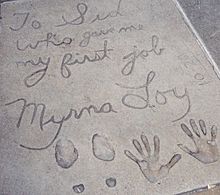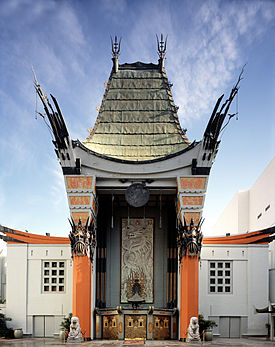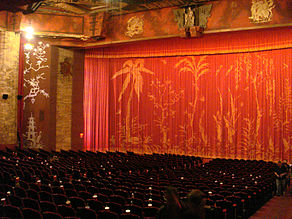- Grauman's Chinese Theatre
-
Grauman's Chinese Theater
Front entrance facing Hollywood Blvd.Location 6931 Hollywood Boulevard
Hollywood, CaliforniaCoordinates Coordinates: 34°6′7″N 118°20′27.5″W / 34.10194°N 118.340972°W Type Indoor movie theatre Built January 16, 1926 Opened May 18, 1927 Renovated 2001-2005 Owner W.F. Cinema Holdings Capacity 1152 Website Grauman's Chinese Theatre Designated: June 5, 1968 Reference #: 55 Grauman's Chinese Theatre, also known as Mann's Chinese Theatre, is a movie theater at 6925 Hollywood Boulevard in Hollywood. It is on the historic Hollywood Walk of Fame.
The Chinese Theatre was commissioned following the success of the nearby Grauman's Egyptian Theatre which opened in 1922. Built over 18 months, from January 1926 by a partnership headed by Sid Grauman, the theater opened May 18, 1927, with the premiere of Cecil B. DeMille's film The King of Kings.[1] It has since been home to many premieres - including the 1977 launch of George Lucas's Star Wars[2] - birthday parties, corporate junkets and three Academy Awards ceremonies. Among the theater's most distinctive features are the concrete blocks set in the forecourt, which bear the signatures, footprints, and handprints of popular motion picture personalities from the 1920s to the present day.
Contents
History
After his success with the Egyptian Theatre, Sid Grauman turned to C.E. Toberman to secure a long term lease on property at 6925 Hollywood Blvd. Mr. Toberman contracted the architectural firm of Meyer & Holler (who had also designed the Egyptian) to design a "palace type theatre" of Chinese design. Grauman's Chinese Theatre was financed by Grauman, who owned a one-third interest, and his partners: Mary Pickford, Douglas Fairbanks, and Howard Schenck.[1] The principal architect of the Chinese Theatre was Raymond M. Kennedy, of Meyer and Holler.
During construction, Grauman hired Jean Klossner to formulate an extremely hard concrete for the forecourt of the theatre. Klossner later became known as "Mr. Footprint," performing the footprint ceremonies from 1927 through 1957.
There are many stories regarding the origins of the footprints. The theater's official account in its books and souvenir programs credit Norma Talmadge as having inspired the tradition when she accidentally stepped into the wet concrete. However, in a short interview during the September 13, 1937, Lux Radio Theatre broadcast of a radio adaptation of A Star Is Born Grauman related another version of how he got the idea to put hand and footprints in the concrete. He said it was: "pure accident. I walked right into it. While we were building the theatre, I accidentally happened to step in some soft concrete. And there it was. So, I went to Mary Pickford immediately. Mary put her foot into it." Still another account by Jean Klossner (the construction foreman at the time) recounts that Klossner autographed his work next to the right-hand poster kiosk and that he and Grauman developed the idea then and there. His autograph and hand-print, dated 1927, remain today. The theater's third founding partner, Douglas Fairbanks, was the second celebrity, after Talmadge, to be immortalized in the concrete.
Sid Grauman sold his share to William Fox's Fox Theatres chain in 1929, but remained as the theater's Managing Director until his death in 1950. Charles Skouras bought the Chinese Theatre which became part of a chain of theatres for his company known as Fox West Coast Theatres. John Tartaglia (also see artist of Saint Sophia (Los Angeles) became the Head Interior Decorator of Grauman's Chinese Theatre as well as the chain of theatres, then owned by Fox West Coast Theatres, in 1952. He would later carry on the work of Jean Klossner, by recommendation of J. Walter Bantau, for the Hollywood Footprint Ceremonies. John performed his first ceremony as a Master Mason for Jean Simmons in 1953, for the first premiere in Cinemascope of "The Robe". Although Jean's replacement was initially thought to be a temporary job for John Tartaglia, his dedication to the job would last as a 35-year career in which he last performed as the Master Mason/Cement Artist in honor of Eddie Murphy in May of 1987 - thereby leaving behind one of the greatest legacies in Hollywood.
The Chinese Theatre was declared a historic and cultural landmark in 1968, and has undergone various restoration projects in the years since then. In 1973 it was purchased by Ted Mann, owner of the Mann Theatres chain, and husband of actress Rhonda Fleming. From then until 2001 it was known as Mann's Chinese Theatre. In the wake of Mann's bankruptcy, the theatre, along with the other Mann properties, were sold in 2000 to a partnership of Warner Bros. and Paramount Pictures, who also acquired the Mann brand name.[3] In 2002 the original name was restored to the cinema palace, although the other theatres in the attached Hollywood and Highland mall retain and continue to operate under the name Mann's Chinese 6 Theatre.[1]
In 2008, the land the theatre sits on was sold to the CIM Group for an undisclosed price. Mann Theatres continues to have a long-term lease on the venue for movie premieres and will continue to operate it as a film house. The land was sold to CIM by the Damon Runyon Cancer Research Foundation of New York and Barlow Respiratory Hospital of Los Angeles. CIM Group also owns the Hollywood and Highland retail mall next door to the Chinese Theatre, as well as numerous other residential and commercial properties in Hollywood.[4] On May 27, 2011 both Grauman's Chinese and the adjacent Mann Chinese 6 were purchased by nightclub owner/producer Elie Samaha and producer Donald Kushner as Chinese Theatres, LLC.[5]
The exterior of the theater is meant to resemble a giant, red Chinese pagoda. The architecture features a huge Chinese dragon across the front, two Authentic Chinese Ming Heavens dogs guard the main entrance, and the silhouettes of tiny dragons up and down the sides of the copper roof. To the dismay of many fans of historic architecture, the free-standing ticket booth was removed (which was not original to the theatre, but rather installed in the 1930s), along with the left and right neon marquees—but their absence brings the theatre back closer to its original state. The auditorium has recently been completely restored along with much of the exterior, however, the wear and tear on the physical structure over the years has caused some of the external décor to be removed, rather than repaired.
In 1944, 1945, and 1946 the Academy Awards ceremonies were held at the Chinese Theatre; they are now held at the adjacent Kodak Theatre.[6]
Grauman's Chinese Theatre continues to serve the public as a first-run movie theater. Many Hollywood films have had their premieres at the Chinese Theatre throughout its history. Today its premieres are attended by celebrities and large throngs of fans as they have been since 1927.
The film premiere of Kevin Kerslake's Electric Daisy Experience and subsequent block party with Kaskade at Grauman's on 27 July 2011 turned into a small riot, including a "field jail" and three arrests. Police shot nonlethal rounds, and the crowd set fires, threw bottles and rocks, and jumped on three police cars, setting one on fire. Three individuals were arrested.[7][8][9][10]
Footprints
 Many older entries contain personal messages to Sid Grauman, such as Myrna Loy's 1936 contribution. Loy's first job was as a dancer at the theater in the 1920s.
Many older entries contain personal messages to Sid Grauman, such as Myrna Loy's 1936 contribution. Loy's first job was as a dancer at the theater in the 1920s.
There are nearly 200 Hollywood celebrity handprints, footprints, and autographs in the concrete of the theater's forecourt.
Variations of this honored tradition are imprints of the eye glasses of Harold Lloyd, the cigar of Groucho Marx, the magic wands of Harry Potter stars Daniel Radcliffe, Emma Watson and Rupert Grint, the legs of Betty Grable, the fist of John Wayne, the knees of Al Jolson, the ice skating blades of Sonja Henie, and the noses of Jimmy Durante and Bob Hope.
Western stars William S. Hart and Roy Rogers left imprints of their guns. The hoofprints of "Tony", the horse of Tom Mix, "Champion", the horse of Gene Autry, and "Trigger", the horse of Rogers, were left in the concrete beside the prints of the stars who rode them in the movies.
The first person not associated with the movie industry to have a signature and handprint in front of the theater is Grauman's mother.[citation needed] On February 19, 2011, Los Angeles Lakers superstar Kobe Bryant became the second person outside the movie industry to be so honored when he had his handprints and footprints embedded.[11] Additionally, Charles Nelson, the winner of a "Talent Quest," had his handprints and footprints embedded in the "Forecourt of the Stars."
Full list of footprint and handprint ceremonies
Main article: List of handprints in front of Grauman's Chinese TheatreSee also
- Los Angeles Historic-Cultural Monuments in Hollywood
References
- ^ a b c "Mann Theatres - Grauman's Chinese". Mann Theatres. http://www.manntheatres.com/chinese/index.php. Retrieved April 17, 2007.
- ^ Starwars.com: Star Wars at the Chinese Theatre
- ^ "Business - Chicago Sun-Times". Chicago Sun-Times. January 12, 2000. http://www.findarticles.com/p/articles/mi_qn4155/is_20000112/ai_n9600152. Retrieved April 17, 2007.[dead link]
- ^ Vincent, Roger (February 28, 2004). "Trizec Completes Sale of Multiuse Complex". Los Angeles Times. http://articles.latimes.com/2004/feb/28/business/fi-holly28. Retrieved 2008-12-18.
- ^ Miller, Daniel (April 28, 2011). "Grauman's Chinese Theatre to Be Sold to Producers Elie Samaha, Don Kushner". The Hollywood Reporter. http://www.hollywoodreporter.com/news/graumans-chinese-theatre-be-sold-183344. Retrieved May 3, 2011.
- ^ "IMDb: Academy Awards, USA". IMDb. http://www.imdb.com/Sections/Awards/Academy_Awards_USA/. Retrieved April 17, 2007.
- ^ Lloyd, Jonathan; John Cadiz Klemack (28 July 2011). "Three in Custody After Hollywood Boulevard Violence". KNBC. http://www.nbclosangeles.com/news/local/Three-in-Custody-After-Hollywood-Boulevard-Violence-126316263.html. Retrieved 28 July 2011.
- ^ "Near-riot in Hollywood: Tourists caught up in 'Electric Daisy' chaos". Los Angeles Times. 28 July 2011. http://latimesblogs.latimes.com/lanow/2011/07/electric-daisy-carnival-hollywood-kaskade.html. Retrieved 28 July 2011.
- ^ Nordyke, Kimberly; Charlie Amter, Lesley Goldberg (28 July 2011). "'Electric Daisy' Doc Premiere Causes Riot in Hollywood". The Hollywood Reporter. http://www.billboard.com/news/electric-daisy-doc-premiere-causes-riot-1005296352.story#/news/electric-daisy-doc-premiere-causes-riot-1005296352.story. Retrieved 28 July 2011.
- ^ Blankstein, Andrew; Sam Quinones (27 July 2011). "Electric Daisy film premiere: LAPD arrests 2, releases dozens as Hollywood crowd disperses". Los Angeles Times. http://latimesblogs.latimes.com/lanow/2011/07/electric-daisy-carnival-hollywood-arrests-police.html. Retrieved 28 July 2011.
- ^ McMenamin, Dave (January 20, 2011). "Kobe Bryant to get Hollywood honor". ESPNLosAngeles.com. http://sports.espn.go.com/los-angeles/nba/news/story?id=6042994. Retrieved January 21, 2011.
External links
- Grauman's Chinese Theatre official website
- Clickable Map of star handprints & footprints
- Map and list of celebrity handprints
- Sid Grauman's Chinese Theatre (Historic Photos)
- Chinese Theater Footprints
Preceded by
The Ambassador Hotel
Los AngelesVenues of Oscars
1944 - 1947Succeeded by
Shrine Auditorium
Los AngelesGreater Hollywood Districts and
neighborhoodsBeachwood Canyon · Cahuenga Pass · East Hollywood · Hollywood · Hollywood Dell · Hollywood Heights · Hollywood Hills · Laurel Canyon · Little Armenia · Melrose District · Melrose Hill · Nichols Canyon · Outpost Estates · Spaulding Square · Sunset Hills · Thai Town · Virgil Village · Whitley Heights · Yucca Corridor
Points of
interestGriffith Park · Grauman's Chinese Theatre · Hollywood and Highland · Hollywood Boulevard · Hollywood Sign · Walk of Fame · Kodak TheatreSee also Downtown · Eastside/Northeast · Harbor Area · Greater Hollywood · Westlake/Silver Lake/Los Feliz · San Fernando and Crescenta Valleys · South Los Angeles · Westside · WilshireLos Angeles Historic-Cultural Monument Lists Downtown Los Angeles • East and Northeast Sides • Harbor Area • Hollywood • San Fernando Valley •
Silver Lake, Angelino Heights and Echo Park • South Los Angeles • Westside • Wilshire and Westlake AreasCategories:- Cinemas and movie theaters in California
- Theatres in Hollywood, California
- Culture of Los Angeles, California
- Theatre companies in Los Angeles, California
- Hollywood history and culture
- Landmarks in Los Angeles, California
- Movie palaces
- Walks of fame
- Event venues established in 1927
Wikimedia Foundation. 2010.


